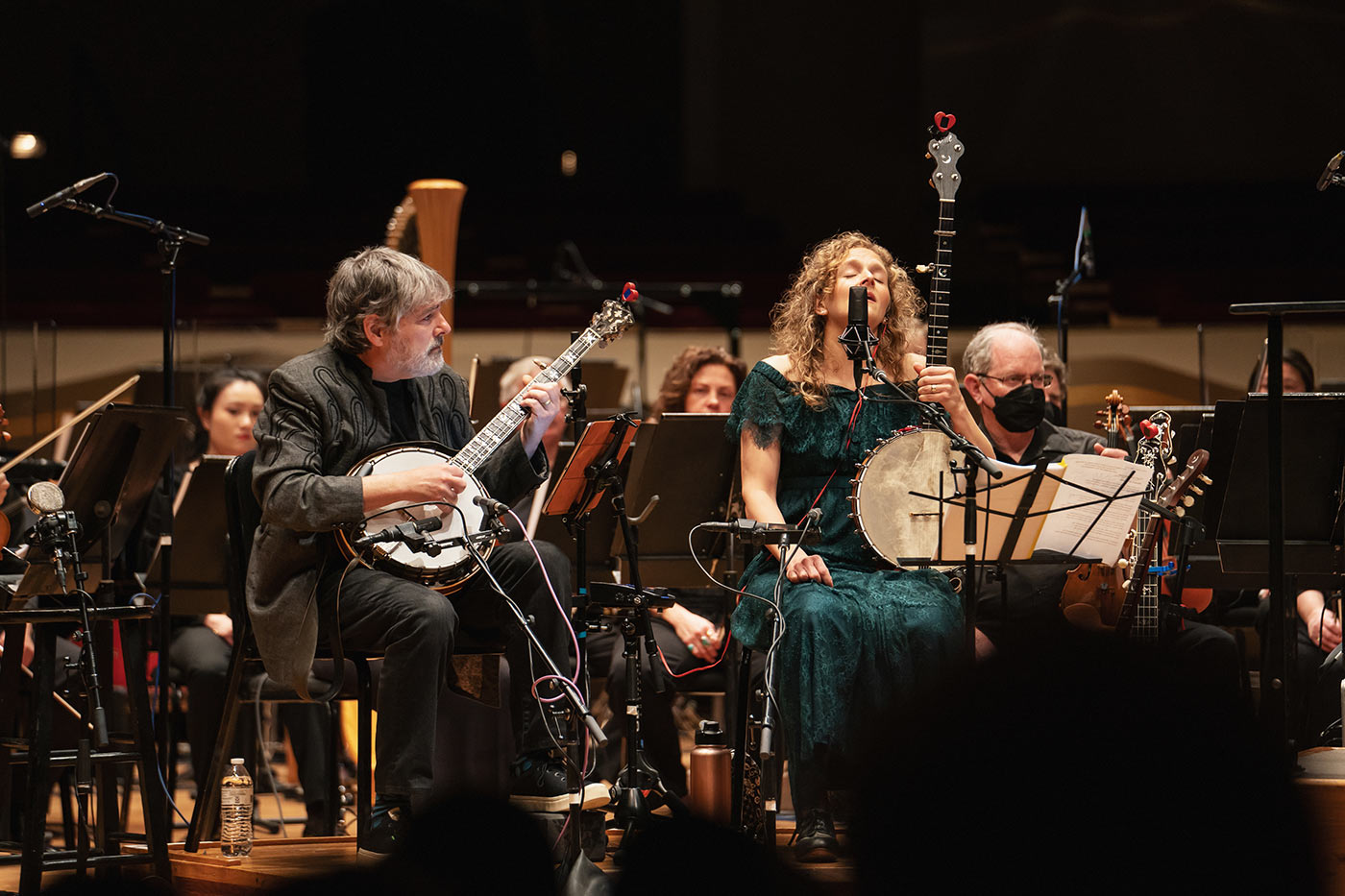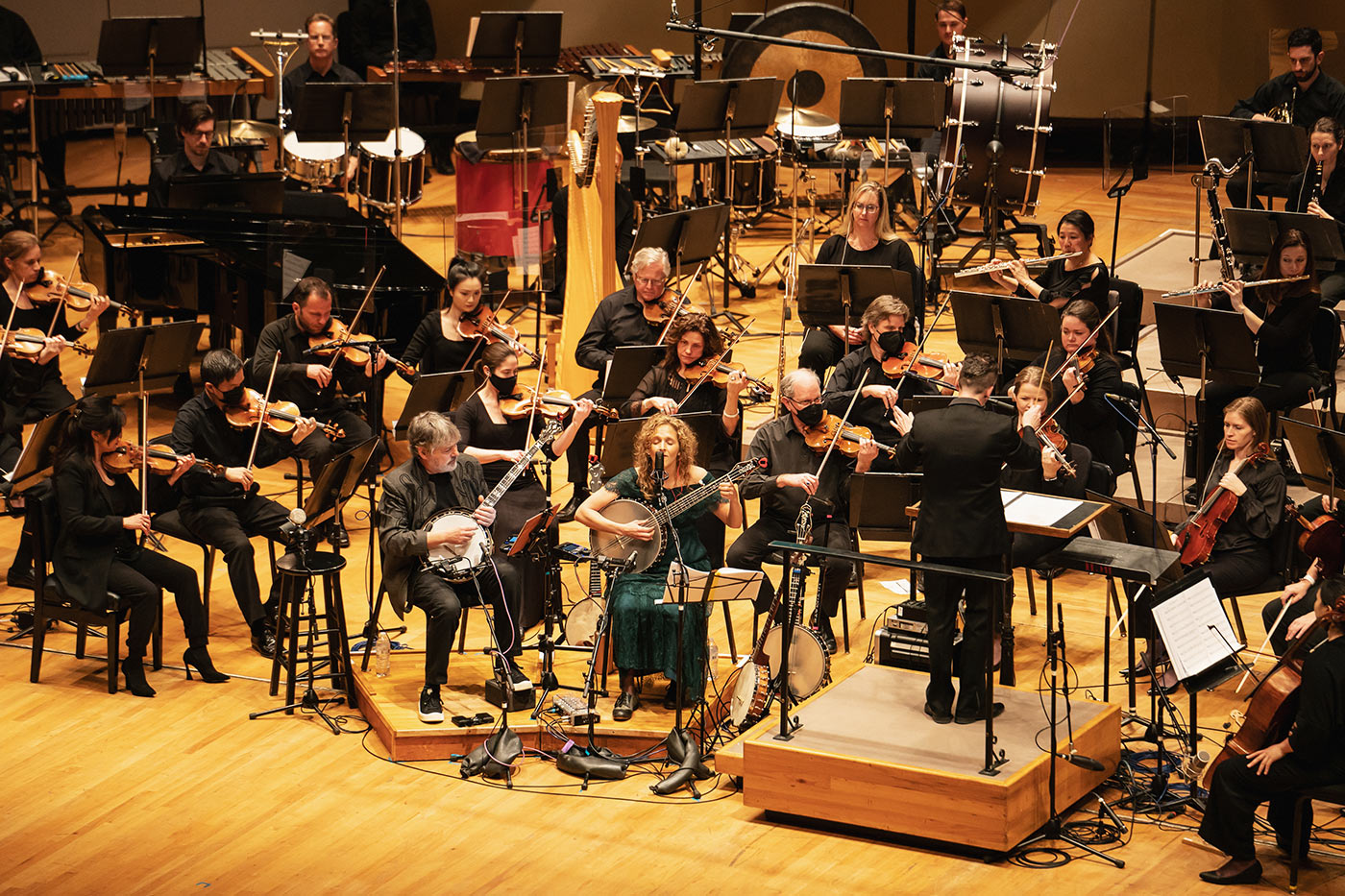BELA FLECK
EXPLORES SANKEN MICS
Béla Fleck Explores Dual Diaphragm and 100kHz Sanken Microphones
Béla Fleck and Abigail Washburn perform in Denver with the Colorado Symphony. Sanken CUX-100K mics are on banjos and a CU-44X MkII is on Amanda’s vocal. Photo by Amanda Tipton.
Béla Fleck and Abigail Washburn perform in Denver with the Colorado Symphony. Photo by Amanda Tipton.
Click on images for high res versions
Learn more about Béla Fleck: belafleck.com
Nashville, TN, July 2023 — Acclaimed banjo virtuoso Béla Fleck is also a proficient producer and recording engineer. As an ambassador of the banjo, Fleck has taken the instrument from its Bluegrass roots to Jazz, Classical, Rock, and various world music genres. The recipient of multiple Grammy Awards going back to 1998, Fleck’s total Grammy count is 15 wins and 27 nominations. He has been nominated in more different categories than any instrumentalist in Grammy history.
Fleck has been exploring three innovative Sanken microphones, the dual titanium capsule CU-44X MkII and the wide-band 20Hz >100kHz CO-100K and CUX-100K mics. An engineer as well as musician, Fleck describes his early work with legendary Nashville producer/engineer Bill VornDick, “I’m a banjo player and I’ve been making my own records since the 80s. As I went along, I found myself fascinated by the process of making records and basically nudging the engineer away from the desk and taking over, because I wanted to figure out how everything worked for myself.” Fleck was fortunate to have learned from VornDick, who had guided numerous successful artists, such as Alison Krause. “I spent a lot of time with Bill, who was okay with my engineering ambitions! He let me, Jerry Douglas and Edgar Meyer and guys like that have our way – and learn our way around recording as if we were engineers, because we were very picky about how we sounded.” Béla Fleck is often considered the premier banjo player in the world.
A New York City native, he picked up the banjo at age 15 after being impressed by the Bluegrass music of Flatt & Scruggs. Since releasing his first solo album in 1980, Fleck has continued to make a name for himself. In 2022, Fleck’s “My Bluegrass Heart” won the Grammy for Best Bluegrass Album.
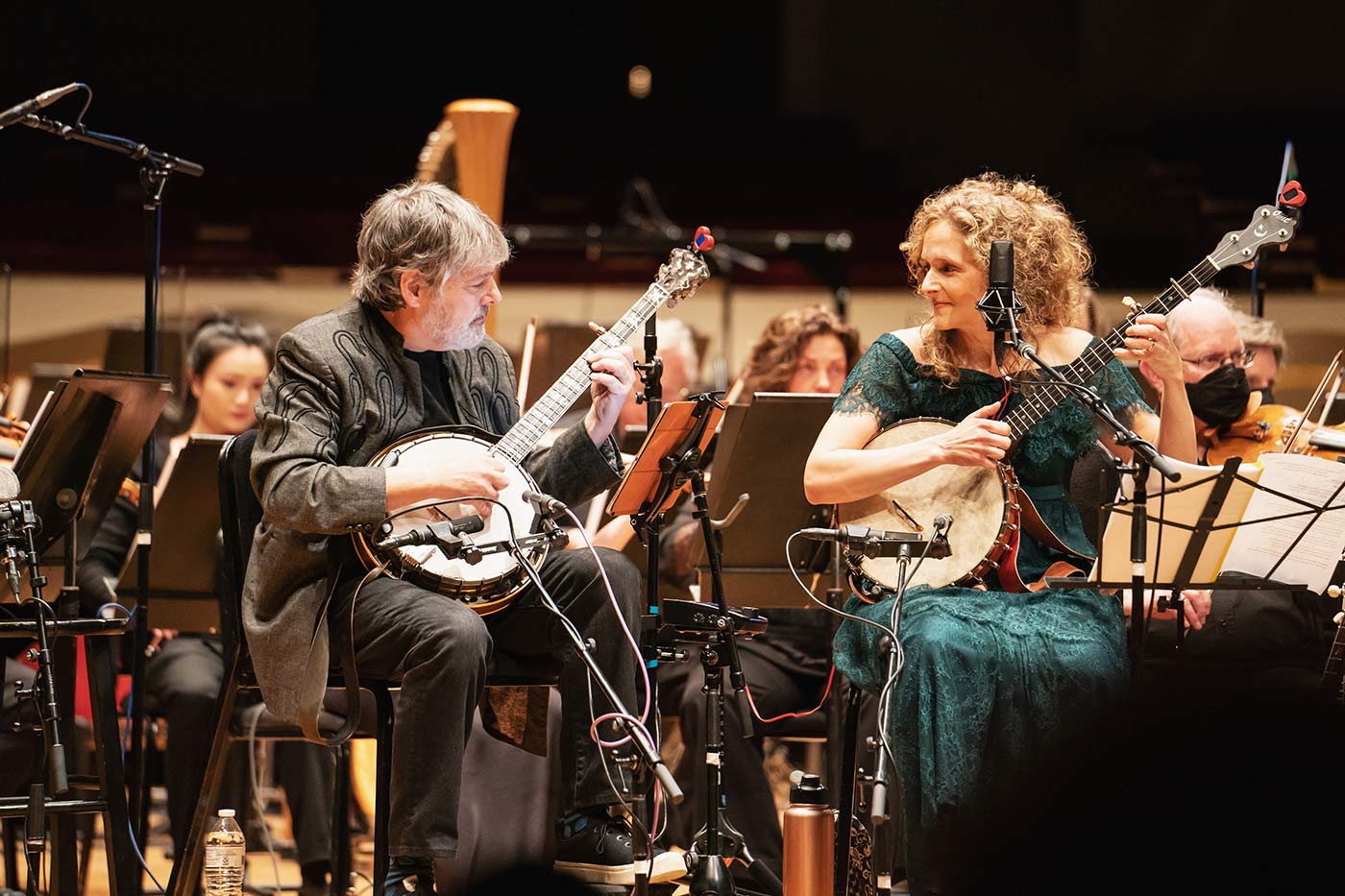
Fleck was introduced to a number of classic microphones by Bill VornDick, including vintage Neumanns, and he’s been collecting microphones ever since. “During the pandemic,” he explains, “I was invited to do a collaboration with an opera singer named Jamie Barton, and the engineer was Chuck Ainlay. It was the first session I’d done in a long time that wasn’t done in my studio with my own mics. Ainlay said, ‘Well, let me just put a few things up for you.’ And he put up the 100K mics. I was unfamiliar with Sanken, but those mics just knocked my socks off. We recorded the banjo and used a pair of the CO-100Ks.
Opera superstar Jamie Barton was on the CU-44X MkII. They gave me the tapes to edit after we did a bunch of takes, so I was able to make sure we had the best edit possible from what we had recorded.” Back at his own studio, Fleck got to work. “I took the material home and when I started listening, I was just blown away by how good the 100K’s sounded. It was really good for me, because my banjo tends to be quite dark, and I always revere the darkness. People tend to think of banjo as being a very bright instrument. I want them to expand their idea of what the banjo can be. In the old days before Bluegrass, the banjo was often tuned way down and it was much, much darker and richer — it’s a lovely sound, harkening back to the sound of the African banjo where it originally came from. Also, there was a great banjo player named John Hartford who liked to tune his banjos down and he was a hero of mine. The problem with tuning your banjo down is a lot of times it disappears in the mix. It sounds really great by itself, but once you start playing with other instruments, you have trouble discerning it and it can disappear.”
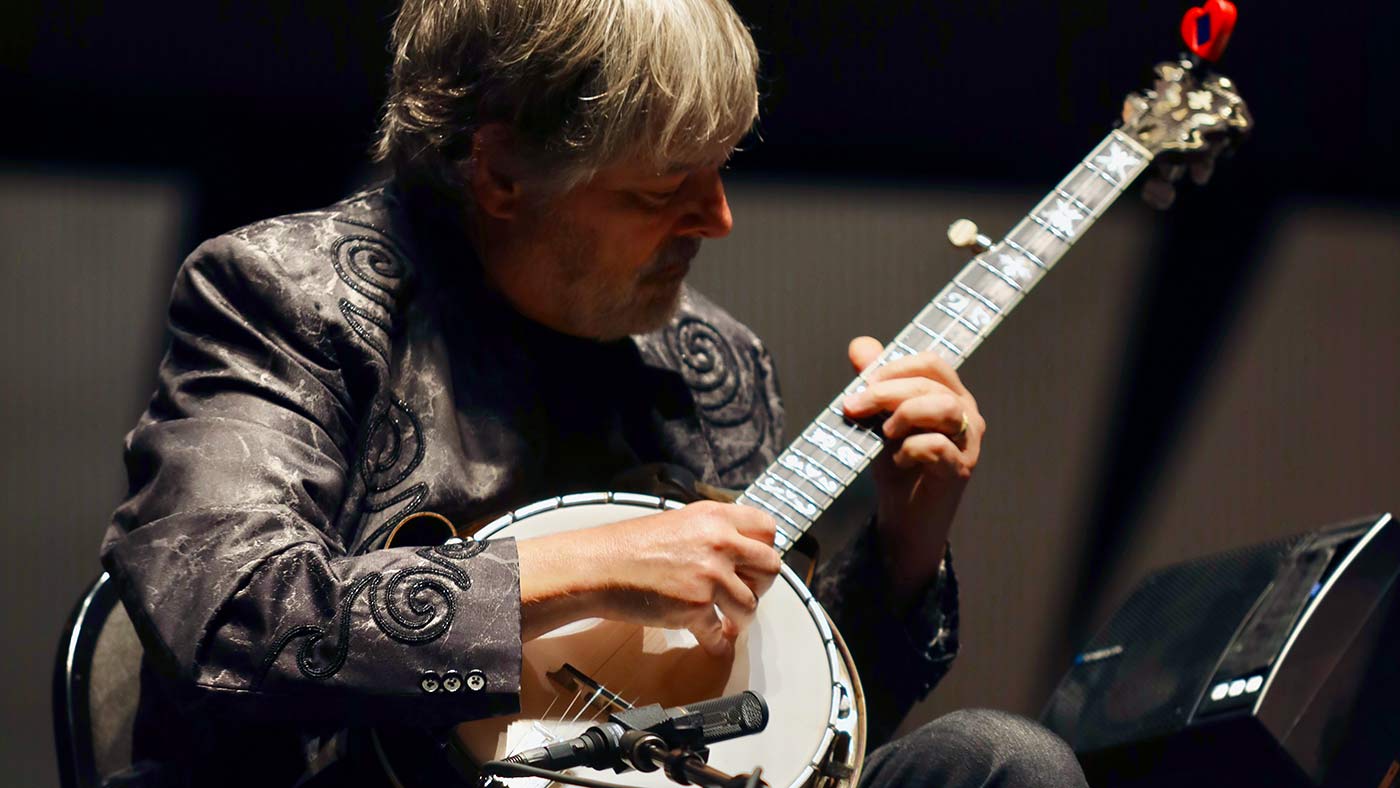
Fleck started using different microphones. “I started moving towards brighter mics and mics that captured the harmonics, so I could still have a dark sound but it would still come through and sound clear. That was when I discovered that the CO-100K was a great mic for me. I immediately ordered a pair of them, and I’ve been using them ever since on all kinds of instruments. Since then, one of my mandolin friends and heroes, Sam Bush, got to use them and said it was the best his mandolin had ever sounded. He’s a picky guy, too.” Fleck continued his microphone exploration with Ainlay’s advice. “In my Bluegrass ensemble my dark banjo has to cut through all these guitars, dobros, basses, mandolins, fiddles, all in the same range. And that mic is really helping me in that situation to not only get a clear sound, but a quality clear sound. Not just bright, I don’t want it to be harsh, just a full range sound that captures everything on the high end of the banjo as well as the bottom. I’ve been very happy with that mic.” Sanken’s CU-44x MK II microphone has a revolutionary design featuring two titanium matched capsules for low and high, with 100-volt internal power for super wide dynamic range and headroom. The transformerless design, with a slight bump above 14kHz gives a pleasing air in the high end with remarkable transient response.
Fleck describes his experience with the CU-44X, “My wife Abigail Washburn and I recently did a song cycle with the Colorado Symphony, recording the premiere for an album. It was a very daunting recording and I started thinking about meddling, as I usually do on the mic choices. I brought my 100Ks, put one on each of us. And when she was singing, I thought, what should we use? I called Chuck and I asked him if he thought the 44X that we used on Jamie Barton would work in a live situation for Abigail’s voice. He said, ‘Yes, you really should try it. It will work well.’ I was concerned that it would pick up the whole stage and turn into a feedback nightmare, but I used it on Abby’s voice, and it was great, really excellent, and it was different from what we were used to using. We’ve been tending to use a C-24 on her voice with both capsules and it’s been a great sound in the home studio when we’re making our records at home. But this was a different situation and I suspect this will be our go-to stage mic for her voice for a long time. And I use it on my banjo now as well, just because it’s such a unique sounding microphone. It can handle the power. It doesn’t seem like it’s going to give out if you play or sing really strong. I bet you could play saxophones directly into it, and it would be fine.”
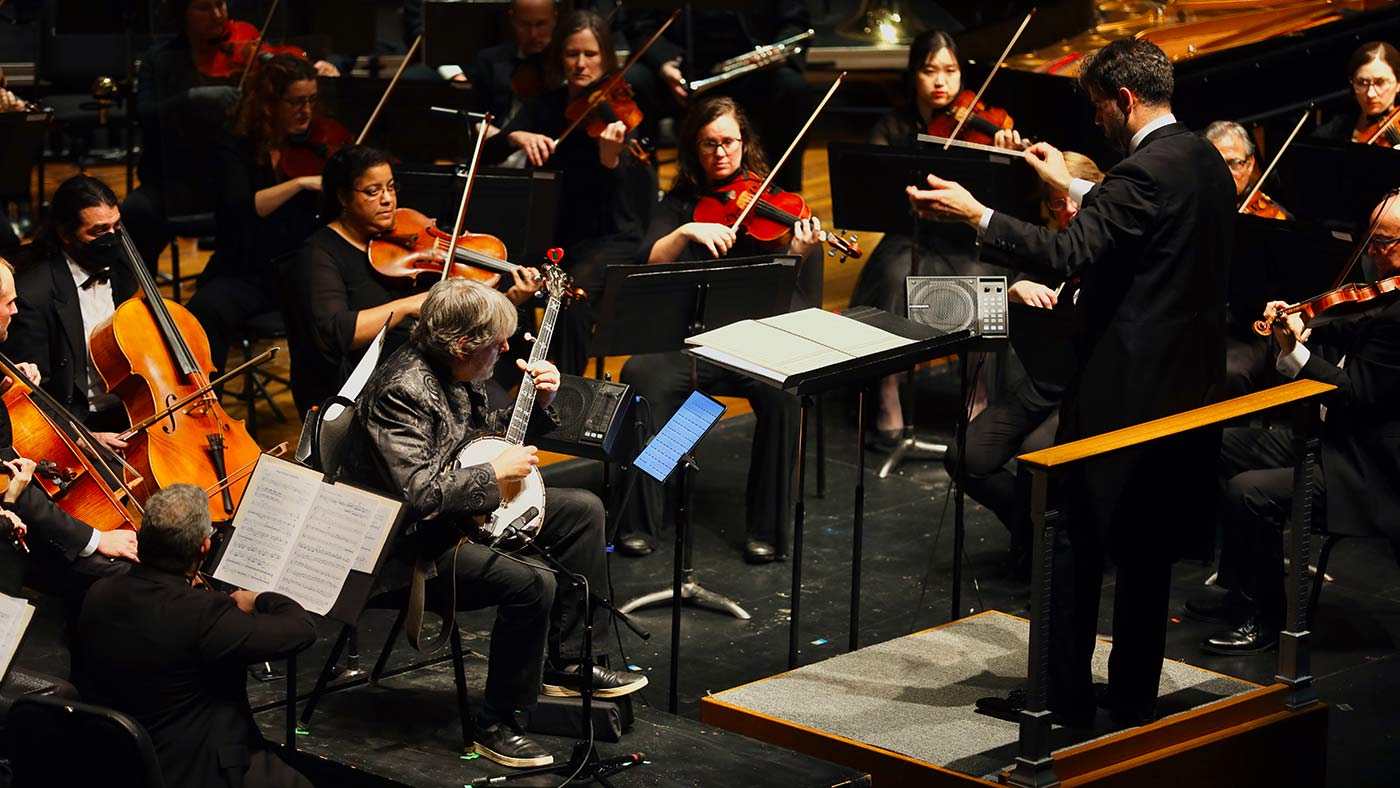
Fleck elaborates on how Abigail’s voice works with the CU-44X, “She sings some really strong notes, and it holds up quite well. This mic has a very rich sound, but it also has a clarity. And it’s almost like it’s already mixed, already done with a quality sound. I remember watching Jamie Barton, with her unbelievable opera voice, one of those huge, powerful fill-up-the-room singers. And again, I was editing the music that we had recorded together. I noticed watching her while we were recording that she was all over the place. She wasn’t eating the mic like a country singer or a rock singer would do. She would be three feet from the mic and then she’d be a foot from the mic, sometimes she’d be right on it. She was all over the place. “And yet the proximity didn’t seem to change when I was going back and forth. I could use part of one line and part of another line and balance out the level and the sound seemed to be the same. I thought that was a real plus, especially for someone like Abigail, who’s going to sing a lot of different ways and a lot of distances from the mic with an orchestra. And it’s worked out really, really well.”
Fleck used a combination of the 44X and the 100K Sanken’s. “I’ve also now used the 44X on my banjo along with the 100K. It’s a double-miking situation where you have two different mics, miking different parts of the banjo. Of course you do have to get them in phase. The result is a very full range sound with a lot of interesting characteristics. I think it’s a great mic that could be used in all kinds of ways. It’s clearly a great vocal mic. It’s clearly a great instrument mic. I know people who use them as overheads for drums and other percussion. It’s a high-class mic and I’m glad to have it in my arsenal.”
Fleck has encountered and solved problems such as monitor feedback when taking a primarily studio microphone into a live concert hall. “The secret weapon is our in-ear monitors. When I play with my Bluegrass band and I’m using the CUX-100K with the Cardioid (Near) setting, it’s a stage full of people that are all playing on nice mics, high quality mics, but there are no monitors on stage; it’s all going directly into our ears. So, we don’t have the vicious cycle of feedback. It’s not going to happen unless the PA is poorly mounted or is right on the stage next to us. We get to have these great mics and present a very high-quality sound to the audience. Same thing when I used the 44X with Abigail. We were right there with the orchestra, and she used a single-ear headphone in one ear on a wireless pack, so she could hear just enough of herself to avoid getting swamped by the orchestra. There was no live monitor feeding the mic back into itself to create feedback. That is the trick that made it possible for us to use these special mics in the rooms that we’ve played in. When you’re playing with an orchestra, the orchestra isn’t even miked. They are just filling up the room naturally and we’re just miking the banjo and the vocals to that natural mix and turning them up just enough to compete.”
Learn more about Béla Fleck: belafleck.com

